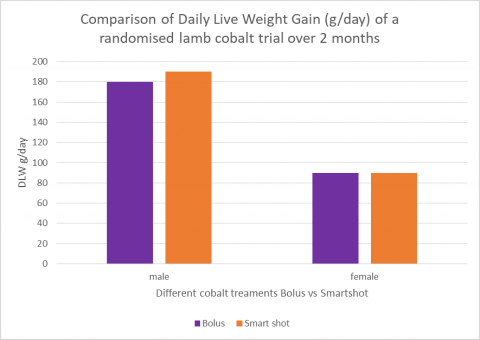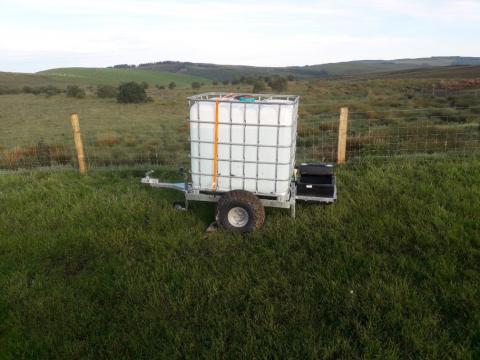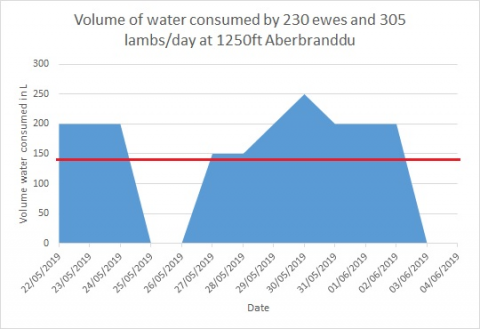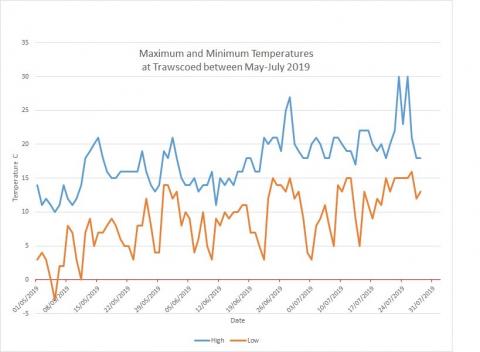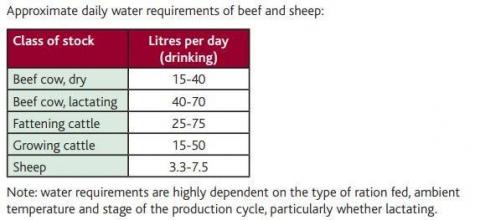Demonstration Site Project - Aberbranddu
Evaluating Lamb Performance
Irwel Jones, Aberbranddu, Pumsaint has been proactive in collecting data for a few years, and as a result has identified that lamb DLWG’s are not satisfactory. Keeping in mind that the ewes are Tregaron type Welsh mountain and comparing their lambs DLWG’s with a terminal cross would be naïve, however he still feels that their growth rates could achieve 80g/day more than current performance.
The aim of the project will be to assess and evaluate the lamb’s performance. In order to achieve this, data capturing, analysis, and various sampling procedures will be undertaken.
Prior to lambing, 20 barren ewes will be sent away for post mortems where major production limiting disease will be looked for, including; Ovine Pulmonary Adenocarcinoma (Contagious lung cancer), Maedi Visna, Caseous Lymphadenitis, Borders disease, Johnes disease.
Any other abnormalities identified during the post mortem will also be noted i.e. causes of abortion, fluke infestations etc.
We will also take liver samples to test for trace elements as sheep are not bolused therefore results will give a true reflection of the trace element status within the flock.
Three weeks prior to lambing we will select 20 ewes of different body condition scores to undertake Metabolic Profiling (BHB, Mag, Urea, Albumin and copper) to investigate the nutritional state of the ewes. By having this data, we can alter the ration before lambing if needed and make better decisions on nutrition next year.
During lambing will also be taking colostrum samples from the ewes to test its quality and will also be taking blood samples from the lambs of these ewes to assess protein concentration in the blood as a guide to immunoglobulins uptake from colostrum. The data from the colostrum testing will again pick up any nutrition issues, and by tracking the lambs we can possibly see if there are any differences in lamb DLWG between those receiving poor and high-quality colostrum.
If we are to be successful in this long-term project of identifying the weakness in lamb finishing at Aberbranddu we must evaluate every stage. This first stage we hope to identify if pre-lambing nutrition was correct.
Project Update:
Evaluating Lamb Performance - project update
Rotational grazing at 1250ft
Project Aims:
- To demonstrate the process of converting from a set stocking beef and sheep farm to a rotational grazing system and the associated benefits.
- This project will highlight all the practical considerations of dividing the farm up and installing all relevant infrastructure and provide a blue print to such conversions.
Strategic Objectives:
- Improve grass utilisation, growth and quality through rotational grazing.
Project in practice:
- 29ac block of improved hill ground has been identified and will be split into 9 paddocks consisting of 6x 2.54ac blocks and 3x 4.69ac blocks
- Assessment of feed requirement of livestock on farm to identify the most suitable animals to use in the rotational system – during the 1st grazing season under the new management system sheep will be prioritised.
- Calculation of predicted DM intakes, assessment of labour availability.
- Design of cells taking into account, topography, aspect, water, power and personnel/animal movement.
- Instillation of designed system.
- Training for client in the correct, efficient use of permanent/temporary fencing equipment and water systems.
- Ongoing support to set-up and manage the grazing rotation.
Project update:
Rotational grazing at 1250ft (1) - 16/06/2017
Rotational grazing at 1250ft (2) - 24/07/2017
Rotational grazing at 1250ft (3) - 18/10/2017
Five Options for Lamb Finishing
Project aims:
To evaluate the most cost-effective and efficient lamb finishing systems to maximise output and profitability.
Strategic objectives:
- Improve business resilience
- Enhance production efficiencies
- Opportunities to reduce impact from ruminant livestock by reduced finishing times
- Reducing reliance on bought in feed
- Improved productivity and cost management
Project in practice:
- 310 lambs split into five even groups of 62 lambs with an average group weight of 32kg for finishing on five different systems.
- Option 1: Grazing a forage rape and Italian Ryegrass mix. Yield will be measured and stocking densities calculated. The field will be strip grazed with a back fence for effective utilisation.
- Option 2: Grazing new reseed - a long-term ley sown in May 2015. Regular measuring with a plate meter will calculate kgs of dry matter per hectare available and the guide area required to achieve target lamb growth rates.
- Option 3: Grazing an old ley of at least 10 years old only. Dry matter will also be measured and the daily demand of the lambs calculated.
- Option 4: Grazing an older ley, along with feeding lamb finishing concentrates. Creep will be fed in relation to grass growth and the number of lambs, rather than ad-lib.
- Option 5: Housed lambs fed concentrates. A group of housed lambs will be fed a concentrate with a crude protein of 14%-16% and straw.
- After three weeks, lambs will be weighed every fortnight until they are fattened by the end of November.
- Record the number of days to finishing, the kg of lamb sold per hectare, volume of concentrate used, any health issues and all costs and return on investment.
Project Introduction: 5 options for lamb finishing
Project update:
Aberbranddu Demonstration Site Video
Project helps evaluate profitable and practical lamb finishing options
Final Report: The value of high quality grass in lamb finishing systems
Comparing different methods of cobalt treatment in randomised test in lambs
Project Aims: Assess the effectiveness of two different modes of supplementing lambs with cobalt (injectable vs bolus) by looking at their weight gain and any deaths.
Provide good evidence for making informed decisions when advising farmers on how to prevent cobalt deficiency through supplementation. Improve long-term lamb welfare and economic growth by preventing cobalt deficiency.
Project results:
|
Project data |
Number of lambs |
Bolus Daily Live Weight Gain (DLWG) in g |
Number of lambs |
Smart shot DLWG in g |
|
Male |
150 |
180 |
127 |
190 |
|
Female |
127 |
90 |
155 |
90 |
|
Average |
|
135 |
|
140 |
|
Cost/lamb £ |
£0.50 /lamb |
|
£0.75 /lamb |
|
-------- Average DLWG for all lambs was 137.5g/day
When carrying out metabolic tests on a sample of this years lambs (2019) they were shown to have cobalt deficiency. As part of their treatment we wanted to see if there was any difference between a bolus vs injectable treatment. The results to date (after 64 days) showed no difference between the two groups showing that both the bolus and injection were equally effective over the 2 month period. The alternative to a bolus or injection would be a drench which is a cheaper alternative to the treatments trialled however this depends on how many times it has to be repeated and whether the extra labour costs are taken into account. There was significant difference between the DLWG between males and female lambs but this was not due to the different form of cobalt given.
Pneumonia control in sheep flock
Pneumonia and pleurisy cause a negative cost to the farmer in reduced growth rate and cost in carcass rejections (condemnations)
Pneumonia in sheep can be caused by a number of infections but not always pasteurella.
Pasteurellosis is the commonest cause of death and vaccination is an important part of control. However this is not the cause of all coughing sheep.
Pasteurellosis is caused by several strains of bacteria that used to be called Pasteurella and are now called Mannheimia or Bibisternia but I shall refer to Pasteurella.
Irwel has started his lamb vaccination programme earlier so lambs are covered before weaning (stress is a trigger for Pasteurellosis). Despite this a few lambs died in 2018. We wanted to investigate this. One lamb was found dead in June 2019 and was sent for a full post mortem to Carmarthen APHA laboratory.
The lamb died from Pasteurella but infection with Mycoplasma was also confirmed. Mycoplasma pneumonia is reported more in cattle but is probably underreported in sheep. It can be a primary cause of pneumonia, but it also lowers the local immunity allowing other bugs (e.g. Pasteurella) to attack. It can also cause coughing and nasal discharge.
We planned to take swabs from 3 or 4 affected lambs this year to culture for Mycoplasma, but good news for Irwel there have not been any to date.
Mycoplasma is difficult to treat and cannot be eliminated. It responds to oxytetracycline antibiotic but often recurs. Sheep need to develop some immunity to it so blanket treatment of e.g. whole mobs of coughing lambs is not helpful although badly affected lambs or those whose growth is affected should be treated.
- Vaccination is only part of disease control
- Not all coughing is due to Pasteurella
- Investigate problems, speak to your vet about testing available for different problems.
Daily water use by sheep at 1250ft
Project Aims: Rotationally grazing in fields with limited water supply can be a limiting factor. This in field project aimed to measure how much water was actually used over a period of 2 weeks from 22.5.19 – 4.6.19. After this period the sheep/lambs moved rotationally to an area with a water source. The water was changed twice in case of staleness but there was no effect on consumption. This trial will be continued when the sheep return to the fields lacking in a water supply. It is felt that more data needs to be collected before any firm conclusions can be made although initial results show less water was used in practice than the industry figures would suggest.
Fig.2 Graph showing the daily volume of water consumed at 1250ft by a mob of sheep/lambs from a mobile drinking unit.
Fig.2 Graph showing minimum and maximum temperatures at Trawscoed weather station between May - July 2019
The average daily water consumption over the period trialled was 139L/day which works out at approx. 0.6L/day for the ewes (not including the lambs) which is well below the industry standard of 3.3 - 7.5L/day. Whilst this is only part of the full project it shows that this is an area would benefit from further research.
Fig 3. AHDB figures of industry standard water use for livestock.
Welsh Pasture Project
Project aims:
We have selected cross-sector farms located across Wales which will measure and monitor their weekly grass growth rates for Farming Connect’s new Welsh Pasture Project.
Each farm will use a plate meter to collect measurements and will also take monthly samples for quality analysis.
The farms will all measure the growth and quantity of available Dry Matter. They have all been asked to identify and compare different ways of managing grass – but the goal remains the same, to find the system which can best match the supply and demand of livestock needs. Each farm will also address the utilisation of quality feed.
This project will enable you to keep up to date with the progress from each location by clicking on our Welsh Pasture Project map and data.

